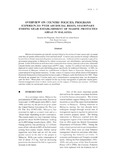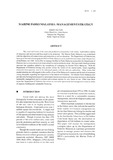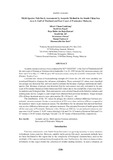| dc.contributor.author | Wagiman, Sukarno bin | |
| dc.contributor.author | Karim, Abdul Khalil bin Abdul | |
| dc.contributor.author | Latun, Abd. Razak bin | |
| dc.date.accessioned | 2019-06-11T03:49:51Z | |
| dc.date.available | 2019-06-11T03:49:51Z | |
| dc.date.issued | 2004 | |
| dc.identifier.citation | Wagiman, S. bin, Karim, A. K. bin A., & Latun, Abd. R. bin. (2004). Overview on country policies, programs experiences with artificial reefs, stationary fishing gear establishment of marine protected areas in Malaysia. In Proceedings of the 1st Regional Workshop on Enhancing Coastal Resources: Artificial Reefs, Stationary Fishing Gear Design and Construction and Marine Protected Areas, 30 September - 3 October 2003, Thailand (pp. 47-55). Samut Prakan, Thailand: Training Department, Southeast Asian Fisheries Development Center. | en |
| dc.identifier.isbn | 9749509641 | |
| dc.identifier.uri | http://hdl.handle.net/20.500.12067/880 | |
| dc.description.abstract | Marine environments are typically strongly linked to the mixing of water masses and, in coastal areas they are greatly influenced by rivers and land runoff. A marine area can also be strongly influenced by activities in distant areas including those on land and at sea. Artificial reef developments is part of the government programme in Malaysia for habitat enhancement and rehabilitation, and artisanal fishing ground. A total of 99 artificial reefs have been constructed from various materials such as tires, fabricated concrete blocks and cylinders, sunken boats and PVC pipes. Another 221 artificial reefs have also been deployed in coastal waters to provide fishing ground specifically for traditional fishermen. In 1983, the Government of Malaysia initiated the establishment of Marine Parks in Peninsular Malaysia for the conservation of living marine resources. To date, waters of 2 nautical miles off the shores of 40 islands in Peninsular Malaysia have been gazetted as marine parks of Malaysia under the Fisheries Act 1985. These 40 islands are grouped into 5 marine parks and a comprehensive management plan was developed to cater for them. These plans were adopted for the day-to-day management of particular marine parks. Current management issues in these marine parks are the impacts of fisheries and tourism. All fishery activities within the marine park waters are prohibited. | en |
| dc.language.iso | en | en |
| dc.publisher | Training Department, Southeast Asian Fisheries Development Center | en |
| dc.subject | Malaysia | en |
| dc.title | Overview on Country Policies, Programs Experiences with Artificial Reefs, Stationary Fishing Gear Establishment of Marine Protected Areas in Malaysia | en |
| dc.type | Conference paper | en |
| dc.citation.spage | 47 | |
| dc.citation.epage | 55 | |
| dc.subject.asfa | Tourism | en |
| dc.subject.asfa | resource management | en |
| dc.subject.asfa | resource conservation | en |
| dc.subject.asfa | fishing gear | en |
| dc.subject.asfa | fishery regulations | en |
| dc.subject.asfa | fishery resources | en |
| dc.subject.asfa | artificial reefs | en |
| dc.subject.asfa | Fishery policy | en |
| dc.subject.asfa | fishery management | en |
| dc.subject.asfa | habitat improvement | en |
| dc.subject.asfa | marine parks | en |
| dc.subject.asfa | stocks | en |
| dc.subject.asfa | protected areas | en |
| dc.citation.conferenceTitle | Proceedings of the 1st Regional Workshop on Enhancing Coastal Resources: Artificial Reefs, Stationary Fishing Gear Design and Construction and Marine Protected Areas, 30 September - 3 October 2003, Thailand | en |




